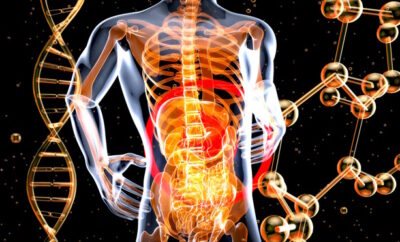
Health x Wellness
Building Strong Muscles for a Strong Immune System
There are over 600 muscles in our bodies. Most of their work goes unseen, so it’s easy to take for granted their role in our overall health. We may feel less fit as we age but attribute it to the inevitability of loss of strength.
After 40, we can lose up to 8 percent of our muscle mass each decade. After the age of 70, that loss can nearly double, up to 15 percent a decade. What few know is that there is evidence that loss of muscle mass is associated with compromised immunity and infections. If an older adult loses more than 10% of his lean body mass, his immunity is affected. Maintaining muscle mass is more important than ever before.
The Active Age (AA) discussed the role strong Muscles play in helping maintain a strong immune system with Abbott’s Nutrition Director, Anna Jacob (AJ) and Singaporean ‘hunkle’ personality, Zheng Ge Ping (GP).
AA: How is our overall immune system connected to muscle strength?
AJ: Muscle strength is one of the key indicators of our overall health, and as muscle mass declines, one may face a higher risk of disability and even loss of independence later in life. Healthy muscles are essential for organ function, skin health, immunity, and metabolism. So, maintaining muscle mass as you age is crucial to a healthy and independent life.
One of the key nutrients that support immune system health is protein. Protein is needed for the building of antibodies and immune system cells. At the same time, increasing protein intake as one ages also helps maintain and rebuild muscle mass.
Furthermore, muscles produce and release compounds that play an essential role in the proliferation, activation, and distribution of some immune cells.
Immunity is affected if an older adult loses more than 10 per cent of his lean body mass. Given the link between muscle mass and immune function, it is critical to maintain muscle mass and strength.
AA: How can we maintain muscle health as we shift into the new normal e.g. WFH, lesser social interaction opportunities, social distancing, etc?
AJ: With the new normal, leading a sedentary lifestyle has become more common, and healthy routines may have been foregone. It makes the role of nutrition more important than ever before. While it is important to ease back into regular exercise to get your muscles active, it is just as essential to ensure you are getting the nutrients your body needs to build and restore muscle mass and strength. Improved nutrient intake, particularly of protein, can contribute to slowing down muscle loss. As one gets older, it is important to make adjustments to your daily nutrition to rebuild or maintain muscle mass and strength, specifically through having a healthy diet rich in protein.
Finding out your muscle age can help you understand where you are currently at with your muscle strength. Muscle age can be determined by performing a simple 5x sit-to-stand test and matching test time to the biological age group using the Muscle Age Calculator. The Muscle Age Calculator is a tool developed by Abbott as part of the 2020 #Stand4Strength campaign to encourage people to pay attention to their muscle strength.
Muscle age may not necessarily be equal to your biological age. An individual in their 40s may have a higher muscle age in the 50s if they take longer than average to complete the 5x sit-to-stand test. Therefore, it is essential to start taking care of muscle strength early to prevent pre-mature muscle loss. It is even more important in the context of increasingly sedentary lifestyles in current times.
AA: What is the connection between nutrition, muscle strength and our immune health system?
AJ: Getting good nutrition is crucial for maintaining and preserving muscle mass and strength, and having a healthy percentage of muscle mass, in turn, contributes to a healthy immune system. Data suggest that muscle mass loss is associated with lower immunity levels and an increased risk of infections.
Nutritional intervention can be an effective way to prevent and minimize age-related loss of muscle mass. Protein is the building block of muscle tissue, and older adults require nearly 50% more protein than younger individuals. Consider increasing your protein intake and ensure that you have an adequate portion of good quality protein for each main meal. Good sources of protein include meat, shellfish, eggs, yoghurt, tofu, nuts, and beans.
Nutrition is the foundation to healthy living and here at Abbott, we believe that proper nutrition is critical for building lifelong health. We aim to deliver innovative nutrition solutions that help people maintain good health outcomes and live their best life. To this end, we have been researching the effects of HMB, also known as beta-hydroxy-beta-methylbutyrate, on muscle tissue building. HMB is found in small amounts in our body and selected foods like avocado and cauliflower. The role of HMB in muscle health has been studied extensively, and the evidence points to HMB’s ability to slow muscle breakdown and support the building of muscle tissue.
However, getting HMB naturally through food alone can be challenging, and HMB levels in the body decline with age. Hence, supplementing one’s diet with oral nutritional supplements containing HMB and high-quality protein can help build and maintain muscle mass. As we age, keeping the body well-nourished can help delay the onset of muscle loss, strengthening overall health and well-being for a better quality of life.
AA: You mentioned previously aiming to do a fitness/modelling shoot at 60, how’s that coming along?
GP: Working towards that goal for my 60th year has been a great motivator for keeping fit. I’ve been keeping up a consistent fitness routine that has me in the gym each week for resistance training. Of course, age does catch up, and it can get challenging at times, maintaining the same level of strength and fitness over the years.
What has made me stick to my fitness routine is knowing that it’s not just about how my muscles look on the outside but also how strong they are. I’m determined to maintain a healthy percentage of muscle mass to minimize the risk of muscle loss brought on by age. By preserving my muscle mass well into my 50s, 60s, and beyond, I hope to stay strong and continue leading an active life doing what I love, such as acting and spending quality time with my family.
AA: Any insights to share from your personal journey about defying physical limitations, diet and nutrition as well as building muscle as one ages?
GP: I hope to continue being active and strong well into the next decade of my life, and this means taking care of my fitness and nutrition now to build and maintain muscle mass. Muscle loss accelerates with age, so it’s important to act early to keep muscle health in check.
I’ve found that having a holistic approach covering both fitness and nutrition support works best for building and maintaining my muscle mass. For the fitness front, I’ve incorporated various forms of resistance and weight training in my exercise workouts. It’s also essential to keep muscles nourished through good nutrition. I have stuck to a healthy diet with plenty of protein and Vitamin D.
Sometimes, it can be challenging to get nutrients from food alone or have completely nutritious meals, especially on busy days with film productions. Therefore, I have been supplementing my diet with daily servings of ENSURE® to support my protein and nutritional intake.
AA: What are your favourite 3 exercises or tips to build muscle?
GP: First of all, establish an exercise routine that features resistance training to build your muscles. Do make sure it’s sustainable for your lifestyle and fitness goals. It’s not about how hard you push yourself physically in a single gym session, but about sticking to a routine that helps you keep active in the long term to maintain healthy muscle mass as you age.
Secondly, it’s important to assess your muscle, and one way to check this is through ‘muscle age’, which indicates the strength and performance of the muscles in the lower limbs. You can determine this with the Muscle Age Calculator, an easy-to-use tool that gives you an idea of whether you are on track with your muscle strength.

All you do is perform the five-times sit-to-stand test as fast as possible, and then match your test time with your specific biological age group online to uncover your muscle age. If you’re taking the right steps to support your muscle strength through good nutrition and exercise, it’s possible that your muscle age may be younger than your biological age. For example, even though I’m 56 years old, my muscle age is only in the 30s!
Lastly, having a nutritious diet packed with protein can help with building muscle mass. While I put in the physical work at the gym, I make sure to complete my nutrition with ENSURE®️. I like to start my mornings with a glass of ENSURE®️ Life, which contains HMB; and high-quality protein that supports muscle tissue building and growth. As a snack after my workouts, I usually drink a bottle of ENSURE® Gold HMB Liquid. It contains high-quality protein, 28 vitamins and minerals such as Vitamin D and Calcium, and comes in a beverage form – perfect for supporting my nutrient intake on the go!









